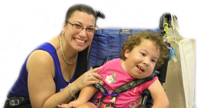Health & Disability
April 3, 2007 • Volume 2, Number 1
Dr. Kimberly Powell is the 2006 AUCD Fellow working as a member of the Developmental Disability Team in the Division of Birth Defects and Developmental Disabilities at the National Center for Birth Defects and Developmental Disabilities (NCBDDD) at CDC. She presented the following study at the 12th Annual MCH EPI Conference on December 6-8, 2006.
Risk Factors for Cerebral Palsy, Mental Retardation, Hearing Loss and Vision Impairment Among 3-10 Year Old Twins in Metropolitan Atlanta
Kimberly K. Powell1, PhD, RD, Sally M. Brocksen2, PhD, Kim Van Naarden Braun3, PhD
Center for Disease Control and Prevention, National Center on Birth Defects and Developmental Disabilities, 1Association for University Centers on Disabilities (AUCD) Fellow, 2Oak Ridge Institute for Science and Education (ORISE) Fellow, 3 Centers for Public Health Research Evaluation and Education, Battelle Memorial Institute
Background
As the prevalence of multiple births has increased over the past two decades, the impact of developmental disabilities among multiple births has become a greater public health concern. Children of a multiple births have been shown to have higher rates of cerebral palsy and may have lower IQ scores in childhood. However, research has not thoroughly examined risk factors for neurodevelopmental problems specific to multiple births and few studies have examined developmental disabilities other than cerebral palsy or the presence of co-existing impairments. This study examines risk factors for four developmental disabilities as well as the presence of co-existing impairments among children of multiple births.
Study Question(s)
What are the risk factors for having a developmental disability among twins 3-10 years of age?
Methods
The Metropolitan Atlanta Developmental Disabilities Surveillance Program (MADDSP) is an ongoing, population-based surveillance system of children with developmental disabilities. The 1991-1994 surveillance years included children ages 3-10 years identified with cerebral palsy, mental retardation, vision impairment, and/or hearing loss with linkages to Georgia Birth Certificate Files. Birth certificate data were also used to randomly select a comparison group of multiple births without a developmental disability. Risk factors were examined using bivariate and logistic regression analyses. The impact of co-twin death and siblings with and without a developmental disability were also examined.
Results
The prevalence of twins was 1 per 1,000 live-births and for twins with a developmental disability was 0.44 per 1,000 among the total population of one-year survivors. Among twin births, the prevalence of at least one of the four developmental disabilities is 19.5 per 1,000 compared with 10.9 per 1,000 among singletons. Bivariate analysis of risk factors indicated that being female, low birth weight, premature, or small for gestational age were significant risk factors for being a twin with a developmental disability.
Conclusions
Twins have an increased risk for developmental disabilities and unique risk factors from singletons.
Public Health Implications
Future studies are needed to evaluate ways to reduce the risk of developmental disabilities among multiple births. Healthcare providers should be aware of the increased risk among multiple births in order to ensure early identification and intervention.
Dr. Powell's Presentation (ppt, 641KB)
< Previous | 3 of 5 | Next >






